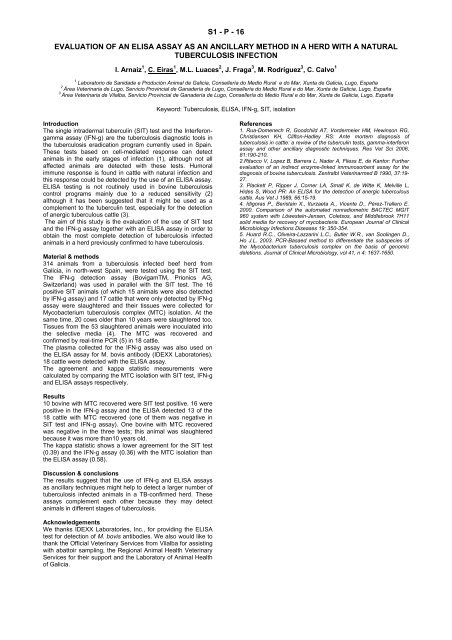Abstract Book of EAVLD2012 - eavld congress 2012
Abstract Book of EAVLD2012 - eavld congress 2012
Abstract Book of EAVLD2012 - eavld congress 2012
You also want an ePaper? Increase the reach of your titles
YUMPU automatically turns print PDFs into web optimized ePapers that Google loves.
S1 - P - 16<br />
EVALUATION OF AN ELISA ASSAY AS AN ANCILLARY METHOD IN A HERD WITH A NATURAL<br />
TUBERCULOSIS INFECTION<br />
I. Arnaiz 1 , C. Eiras 1 , M.L. Luaces 2 , J. Fraga 3 , M. Rodríguez 3 , C. Calvo 1<br />
1 Laboratorio de Sanidade e Produción Animal de Galicia, Consellería do Medio Rural e do Mar, Xunta de Galicia, Lugo, España<br />
2<br />
Área Veterinaria de Lugo, Servicio Provincial de Ganadería de Lugo, Consellería do Medio Rural e do Mar, Xunta de Galicia, Lugo, España<br />
3<br />
Área Veterinaria de Vilalba, Servicio Provincial de Ganadería de Lugo, Consellería do Medio Rural e do Mar, Xunta de Galicia, Lugo, España<br />
Keyword: Tuberculosis, ELISA, IFN-g, SIT, isolation<br />
Introduction<br />
The single intradermal tuberculin (SIT) test and the Interferongamma<br />
assay (IFN-g) are the tuberculosis diagnostic tools in<br />
the tuberculosis eradication program currently used in Spain.<br />
These tests based on cell-mediated response can detect<br />
animals in the early stages <strong>of</strong> infection (1), although not all<br />
affected animals are detected with these tests. Humoral<br />
immune response is found in cattle with natural infection and<br />
this response could be detected by the use <strong>of</strong> an ELISA assay.<br />
ELISA testing is not routinely used in bovine tuberculosis<br />
control programs mainly due to a reduced sensitivity (2)<br />
although it has been suggested that it might be used as a<br />
complement to the tuberculin test, especially for the detection<br />
<strong>of</strong> anergic tuberculous cattle (3).<br />
The aim <strong>of</strong> this study is the evaluation <strong>of</strong> the use <strong>of</strong> SIT test<br />
and the IFN-g assay together with an ELISA assay in order to<br />
obtain the most complete detection <strong>of</strong> tuberculosis infected<br />
animals in a herd previously confirmed to have tuberculosis.<br />
Material & methods<br />
314 animals from a tuberculosis infected beef herd from<br />
Galicia, in north-west Spain, were tested using the SIT test.<br />
The IFN-g detection assay (BovigamTM, Prionics AG,<br />
Switzerland) was used in parallel with the SIT test. The 16<br />
positive SIT animals (<strong>of</strong> which 15 animals were also detected<br />
by IFN-g assay) and 17 cattle that were only detected by IFN-g<br />
assay were slaughtered and their tissues were collected for<br />
Mycobacterium tuberculosis complex (MTC) isolation. At the<br />
same time, 20 cows older than 10 years were slaughtered too.<br />
Tissues from the 53 slaughtered animals were inoculated into<br />
the selective media (4). The MTC was recovered and<br />
confirmed by real-time PCR (5) in 18 cattle.<br />
The plasma collected for the IFN-g assay was also used on<br />
the ELISA assay for M. bovis antibody (IDEXX Laboratories).<br />
18 cattle were detected with the ELISA assay.<br />
The agreement and kappa statistic measurements were<br />
calculated by comparing the MTC isolation with SIT test, IFN-g<br />
and ELISA assays respectively.<br />
References<br />
1. Rua-Domenech R, Goodchild AT, Vordermeier HM, Hewinson RG,<br />
Christiansen KH, Clifton-Hadley RS: Ante mortem diagnosis <strong>of</strong><br />
tuberculosis in cattle: a review <strong>of</strong> the tuberculin tests, gamma-interferon<br />
assay and other ancillary diagnostic techniques. Res Vet Sci 2006,<br />
81:190-210.<br />
2.Ritacco V, Lopez B, Barrera L, Nader A, Fliess E, de Kantor: Further<br />
evaluation <strong>of</strong> an indirect enzyme-linked immunosorbent assay for the<br />
diagnosis <strong>of</strong> bovine tuberculosis. Zentralbl Veterinarmed B 1990, 37:19-<br />
27.<br />
3. Plackett P, Ripper J, Corner LA, Small K, de Witte K, Melville L,<br />
Hides S, Wood PR: An ELISA for the detection <strong>of</strong> anergic tuberculous<br />
cattle. Aus Vet J 1989, 66:15-19.<br />
4. Idigoras P., Beristain X., Iturzaeta A., Vicente D., Pérez-Trallero E.<br />
2000. Comparison <strong>of</strong> the automated nonradiometric BACTEC MGIT<br />
960 system with Löwestein-Jensen, Coletsos, and Middlebrook 7H11<br />
solid media for recovery <strong>of</strong> mycobacteria. European Journal <strong>of</strong> Clinical<br />
Microbiology Infections Diseases 19: 350-354.<br />
5. Huard R.C., Oliveira-Lazzarini L.C., Butler W.R., van Soolingen D.,<br />
Ho J.L. 2003. PCR-Basaed method to differentiate the subspecies <strong>of</strong><br />
the Mycobacterium tuberculosis complex on the basis <strong>of</strong> genomic<br />
deletions. Journal <strong>of</strong> Clinical Microbiology, vol 41, n 4: 1637-1650.<br />
Results<br />
10 bovine with MTC recovered were SIT test positive. 16 were<br />
positive in the IFN-g assay and the ELISA detected 13 <strong>of</strong> the<br />
18 cattle with MTC recovered (one <strong>of</strong> them was negative in<br />
SIT test and IFN-g assay). One bovine with MTC recovered<br />
was negative in the three tests; this animal was slaughtered<br />
because it was more than10 years old.<br />
The kappa statistic shows a lower agreement for the SIT test<br />
(0.39) and the IFN-g assay (0.36) with the MTC isolation than<br />
the ELISA assay (0.58).<br />
Discussion & conclusions<br />
The results suggest that the use <strong>of</strong> IFN-g and ELISA assays<br />
as ancillary techniques might help to detect a larger number <strong>of</strong><br />
tuberculosis infected animals in a TB-confirmed herd. These<br />
assays complement each other because they may detect<br />
animals in different stages <strong>of</strong> tuberculosis.<br />
Acknowledgements<br />
We thanks IDEXX Laboratories, Inc., for providing the ELISA<br />
test for detection <strong>of</strong> M. bovis antibodies. We also would like to<br />
thank the Official Veterinary Services from Vilalba for assisting<br />
with abattoir sampling, the Regional Animal Health Veterinary<br />
Services for their support and the Laboratory <strong>of</strong> Animal Health<br />
<strong>of</strong> Galicia.


